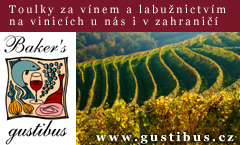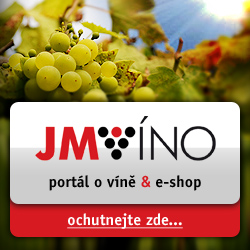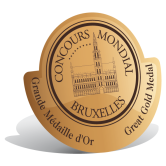
Between 24-27 April one of the most prestigious wine contests took place inside the exhibition centre of Feria-Valencia - Concours Mondial de Bruxelles. Its 16th edition saw 6289 samples from 54 countries, of which 5992 wines and 297 spiritis. Concours Mondial de Bruxelles was founded by Louis Havaux, at the time president of FIJEV (the international federation of journalists and wine writers), now still the editor-in-chief of the bilingual VINO magazine, which is published in the Benelux countries. The competition first took place in 1994 in Bruges, where some 860 samples participated. This number has been growing steadily to today's proportions and so it moved for a period of several years to the Belgian capital Brussels before traversing the whole of Belgium - back to Bruges, then on to Antwerp, Liège, Ostend... In 2006 the decision was made to affirm the event's international character and it headed to Lisbon - at this time Louis' son Baudouin took over the running of the contest. In 2007 the Concours Mondial de Bruxelles was held in Maastricht, this year it was in Bordeaux and today we already know that next year this roving competition will be hosted by the city of Valencia. Now there's another very promising wine region with its own very special gastronomic tradition to whet the appetite. However, despite all these worldly peregrinations, the Concours Mondial de Bruxelles still preserves its "appellation d'origine" status and the reference to the capital city of Europe.
This year the Hilton-Valencia accommodated 250 tasters of 40 nationalitiesí, from New Zealand to Patagonia, Columbia, Venezuela, Mexico and North America, from South America across Tunisia to the whole of Europe and further to Thaiwan and Japan, who at the Feria-Valencia complex sat into 45 tasting committees and spent three days evaluating approximately 50 samples a day. This year I presided Jury No. 14 of four tasters coming from Greece, Portugal and Spain, who were marking the wines very well indeed. Full results and further information on Concours Mondial de Bruxelles can be found on: www.concoursmondial.eu The 2008 edition of one of the largest and most prestigious wine contests - Concours Mondial de Bruxelles - took place between 18-20 April in the Espace Pluriel at the Palais des Congres Bordeaux-Lac. This was the competition's 15th edition which attracted 6,190 samples from 48 countries, of which 5,890 were wines and 299 spirits. I have written in the media of the merits of this renowned international competition on a number of occasions, as I have been participating as a  member of the jury at this contest ever since 1999. To recap, however, Concours Mondial de Bruxelles was founded by Louis Havaux, at the time president of FIJEV (the international federation of journalists and wine writers), now still the editor-in-chief of the bilingual VINO magazine, which is published in the Benelux countries. The competition first took place in 1994 in Bruges, where some 860 samples participated. This number has been growing steadily to today's proportions and so it moved for a period of several years to the Belgian capital Brussels before traversing the whole of Belgium - back to Bruges, then on to Antwerp, Liège, Ostend... In 2006 the decision was made to affirm the event's international character and it headed to Lisbon - at this time Louis' son Baudouin took over the running of the contest. In 2007 the Concours Mondial de Bruxelles was held in Maastricht, this year it was in Bordeaux and today we already know that next year this roving competition will be hosted by the city of Valencia. Now there's another very promising wine region with its own very special gastronomic tradition to whet the appetite. However, despite all these worldly peregrinations, the Concours Mondial de Bruxelles still preserves its "appellation d'origine" status and the reference to the capital city of Europe. member of the jury at this contest ever since 1999. To recap, however, Concours Mondial de Bruxelles was founded by Louis Havaux, at the time president of FIJEV (the international federation of journalists and wine writers), now still the editor-in-chief of the bilingual VINO magazine, which is published in the Benelux countries. The competition first took place in 1994 in Bruges, where some 860 samples participated. This number has been growing steadily to today's proportions and so it moved for a period of several years to the Belgian capital Brussels before traversing the whole of Belgium - back to Bruges, then on to Antwerp, Liège, Ostend... In 2006 the decision was made to affirm the event's international character and it headed to Lisbon - at this time Louis' son Baudouin took over the running of the contest. In 2007 the Concours Mondial de Bruxelles was held in Maastricht, this year it was in Bordeaux and today we already know that next year this roving competition will be hosted by the city of Valencia. Now there's another very promising wine region with its own very special gastronomic tradition to whet the appetite. However, despite all these worldly peregrinations, the Concours Mondial de Bruxelles still preserves its "appellation d'origine" status and the reference to the capital city of Europe.
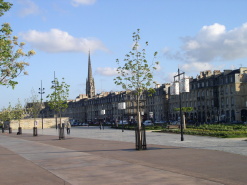 This year several hotels of the Accor group in the complex Bordeaux-Lac, next to the exhibition halls in which the world's largest wine fair VINEXPO takes place every two years, accommodated the 240 invited tasters, who came from all around the world, from New Zealand through Patagonia, Columbia, Venezuela, Mexico and north America, from South Africa through Tunisia to the whole of Europe and as far away as Taiwan and Japan. They sat in 45 tasting committees and for three days marked around 50 samples per day. I attended the event for the 10th time and chaired Jury No. 34, which contained tasters from Hungary, Spain, Italy and France. The contest itelf is a massive undertaking: 180 organisers, sommeliers and students from the Bordeaux hotel school assisited in the running of the competition during which 23,200 bottles were opened, 2,000 Spiegelau glasses used, 34,000 official tasting sheets filled and 29 tonnes of materials recycled plus, of course, 22 kg of corks. This year several hotels of the Accor group in the complex Bordeaux-Lac, next to the exhibition halls in which the world's largest wine fair VINEXPO takes place every two years, accommodated the 240 invited tasters, who came from all around the world, from New Zealand through Patagonia, Columbia, Venezuela, Mexico and north America, from South Africa through Tunisia to the whole of Europe and as far away as Taiwan and Japan. They sat in 45 tasting committees and for three days marked around 50 samples per day. I attended the event for the 10th time and chaired Jury No. 34, which contained tasters from Hungary, Spain, Italy and France. The contest itelf is a massive undertaking: 180 organisers, sommeliers and students from the Bordeaux hotel school assisited in the running of the competition during which 23,200 bottles were opened, 2,000 Spiegelau glasses used, 34,000 official tasting sheets filled and 29 tonnes of materials recycled plus, of course, 22 kg of corks. As is customary at such international gatherings, a full social programme ran parallel with the contest. Guests, mainly from the journalistic sphere, continued to arrive throughout the day of 17th April at 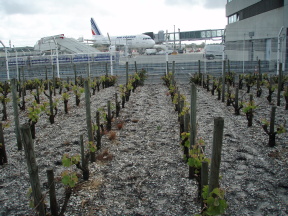 Bordeaux-Mérignac (the only airport in the world with a vineyard!). During the afternoon a workshop organised by Interprofessions du Vignoble de France took place, while at the Hotel Novotel nicely chilled Entre-deux-Mers wines were served as a welcome drink with an endless supply of Arcachon oysters, prepared on the spot. For those arriving from landlocked countries, this was perhaps an invitation to a little over-indulgence. Nevertheless, after this we all transferred across the road to the Sofitel for a copious buffet of local specialities accompanied by a wide vinous range provided by the Conseil Regional des Vins d'Aquitaine. Bordeaux-Mérignac (the only airport in the world with a vineyard!). During the afternoon a workshop organised by Interprofessions du Vignoble de France took place, while at the Hotel Novotel nicely chilled Entre-deux-Mers wines were served as a welcome drink with an endless supply of Arcachon oysters, prepared on the spot. For those arriving from landlocked countries, this was perhaps an invitation to a little over-indulgence. Nevertheless, after this we all transferred across the road to the Sofitel for a copious buffet of local specialities accompanied by a wide vinous range provided by the Conseil Regional des Vins d'Aquitaine. 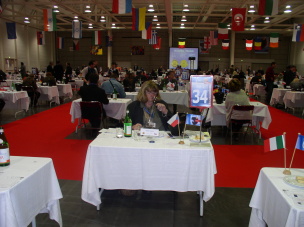 Tasting duties began sharp on 8:30 am the following morning, with the opening speeches and mises en bouche to 'calibrate the collective palate'. There then followed the first four-hour tasting session by committee. After an extensive buffet lunch offered by the Négoce de Bordeaux who presented a selection of brand wines in the Hotel Sofitel, those tasters unfamiliar with this city were taken on an sightseeing tour by bus. That evening the entire assembly transferred via the often jammed Bordeaux ring-road - La Rocade - to Planete Bordeaux, an interactive wine museum and tasting area of Bordeaux and Bordeaux Supérieur wines not far from the city in Beychac et Caillau on the road to Saint Emilion. Tasting duties began sharp on 8:30 am the following morning, with the opening speeches and mises en bouche to 'calibrate the collective palate'. There then followed the first four-hour tasting session by committee. After an extensive buffet lunch offered by the Négoce de Bordeaux who presented a selection of brand wines in the Hotel Sofitel, those tasters unfamiliar with this city were taken on an sightseeing tour by bus. That evening the entire assembly transferred via the often jammed Bordeaux ring-road - La Rocade - to Planete Bordeaux, an interactive wine museum and tasting area of Bordeaux and Bordeaux Supérieur wines not far from the city in Beychac et Caillau on the road to Saint Emilion.
The following day's excursion led us to one of four possible wine tours, in my case to Château du 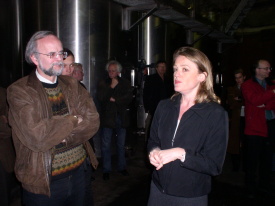 Taillan (www.chateaudutaillan.com), Cru Bourgois Haut Médoc, the first estate one comes to on the road to the Médoc occupying some 100 ha of land, some 11km from Bordeaux. Here, Mme Cruse, one of the five sisters and owners of the château, showed us through the historic chais which have been refurbished and are often used to accommodate large social or business gatherings. On the day of our visit she also expected a hundred or so guests from the Lions Club. Taillan (www.chateaudutaillan.com), Cru Bourgois Haut Médoc, the first estate one comes to on the road to the Médoc occupying some 100 ha of land, some 11km from Bordeaux. Here, Mme Cruse, one of the five sisters and owners of the château, showed us through the historic chais which have been refurbished and are often used to accommodate large social or business gatherings. On the day of our visit she also expected a hundred or so guests from the Lions Club. Château Rauzan-Ségla (www.chateaurauzansegla.com), Second Grand Cru 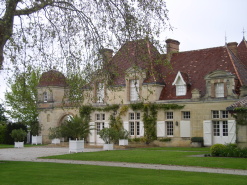 Classé Margaux, is no stranger to us. Indeed, a few years back John Kolassa, its technical director and a prominent figure in Bordeaux, conducted an extensive tasting in Prague which we attended. It is among the finest names in Bordeaux, completely renovated in 1994, is now in the hands of the perfume family Chanel. Classé Margaux, is no stranger to us. Indeed, a few years back John Kolassa, its technical director and a prominent figure in Bordeaux, conducted an extensive tasting in Prague which we attended. It is among the finest names in Bordeaux, completely renovated in 1994, is now in the hands of the perfume family Chanel. On to the Château Giscours (www.chateau-giscours.fr) for tasting of the wines from the Left Bank at the chais plus dinner accompanied by the wines of the château's own production, courtesy of the interprofessional bodies, such as the CIVB, Les Vins de Médoc, Pessac-Léognan, Graves and Sauternes-Barsac. We feasted on Marbré de foie gras de canard with a Sauternes as the CIVB, Les Vins de Médoc, Pessac-Léognan, Graves and Sauternes-Barsac. We feasted on Marbré de foie gras de canard with a Sauternes  jelly, beef Wellington with pleurotes mushrooms and Bordelaise sauce, selection of cheeses and finishing with the Tartelette au chocolat amer et sa créme anglaise... jelly, beef Wellington with pleurotes mushrooms and Bordelaise sauce, selection of cheeses and finishing with the Tartelette au chocolat amer et sa créme anglaise... Next day the first visit after the morning tasting session was to Château Petit-Village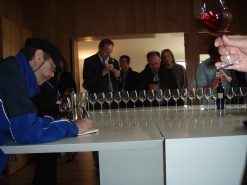 (www.petit-village.com), a newly revamped state-of-the-art establishment in Pomerol, many of whose famous châteaux - garages would be a better description actually - were visible from the upper floor where a modern vinification unit and tasting room has been built very recently. Two wines of two different vintages were tasted, fruity and forward with Merlot being the principal grape variety. (www.petit-village.com), a newly revamped state-of-the-art establishment in Pomerol, many of whose famous châteaux - garages would be a better description actually - were visible from the upper floor where a modern vinification unit and tasting room has been built very recently. Two wines of two different vintages were tasted, fruity and forward with Merlot being the principal grape variety. 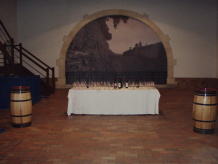 The day continued with a visit to Château Canon (www.chateau-cannon.com), 1er Grand Cru Classé B which is also in the ownership of Chanel, with a visit and tasting of Château Canon and Clos Canon. Later we were deposited on the edge of the famed medieval village of Saint Emilion, where traffic cannot easily penetrate. Unlike rather nondescript The day continued with a visit to Château Canon (www.chateau-cannon.com), 1er Grand Cru Classé B which is also in the ownership of Chanel, with a visit and tasting of Château Canon and Clos Canon. Later we were deposited on the edge of the famed medieval village of Saint Emilion, where traffic cannot easily penetrate. Unlike rather nondescript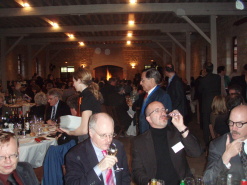 Pomerol, with its ultra-chic wineries often located in humble outhouses, this is a true medieval wonder, with narrow streets, cobblestones, winding alleys and a subterranean church, best visited on foot. The evening's gala dinner in the Salle des Dominicains was hosted by CIVB to showcase wines of the AOC Libournais. During the course of the evening every table was treated to bottles of Châteaux Troplong Mondot 1998, Angélus 1996 and Cheval Blanc 1997. A fitting climax to a wonderfully organised event, as ever. Pomerol, with its ultra-chic wineries often located in humble outhouses, this is a true medieval wonder, with narrow streets, cobblestones, winding alleys and a subterranean church, best visited on foot. The evening's gala dinner in the Salle des Dominicains was hosted by CIVB to showcase wines of the AOC Libournais. During the course of the evening every table was treated to bottles of Châteaux Troplong Mondot 1998, Angélus 1996 and Cheval Blanc 1997. A fitting climax to a wonderfully organised event, as ever.
 Actually this was not the end for a couple of dozen or so of the journalists who had been invited by the Comité Départemental du Tourisme de la Gironde (www.tourisme-gironde.fr) to participate in a trip to discover the region. First, there was the excursion to the Entre-deux-Mers area, a region comprising 1,500 hectares of vineyards and 200 producers, the largest designated area in the Gironde, which lies between the rivers Garonne and Dordogne. White wines coming under the Entre-deux-Mers appellation are made from a combination of Sauvignon, Sémillon and Muscadelle grapes, reds fall under the appellation of Bordeaux and Bordeaux Supérieur. Actually this was not the end for a couple of dozen or so of the journalists who had been invited by the Comité Départemental du Tourisme de la Gironde (www.tourisme-gironde.fr) to participate in a trip to discover the region. First, there was the excursion to the Entre-deux-Mers area, a region comprising 1,500 hectares of vineyards and 200 producers, the largest designated area in the Gironde, which lies between the rivers Garonne and Dordogne. White wines coming under the Entre-deux-Mers appellation are made from a combination of Sauvignon, Sémillon and Muscadelle grapes, reds fall under the appellation of Bordeaux and Bordeaux Supérieur.
The Château de Lisennes in Tresses (www.lisennes.com) is a fine family property with 50 hectares 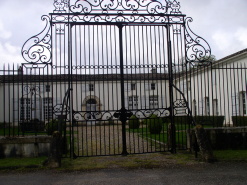 under vine and buildings dating back to the 15th and 16th centuries. The young proprietor, Monsieur Jean-Luc Soubie, produces a variety of wines using modern vinification methods with temperature-controlled fermentation. Annual production is around 360,000 bottles and vineyards are being systematically renewed. Not only Entre-deux-Mers is produced here, as in all wineries visited, reds under the Bordeaux and Bordeaux Supérieur labels were available to sample. under vine and buildings dating back to the 15th and 16th centuries. The young proprietor, Monsieur Jean-Luc Soubie, produces a variety of wines using modern vinification methods with temperature-controlled fermentation. Annual production is around 360,000 bottles and vineyards are being systematically renewed. Not only Entre-deux-Mers is produced here, as in all wineries visited, reds under the Bordeaux and Bordeaux Supérieur labels were available to sample. 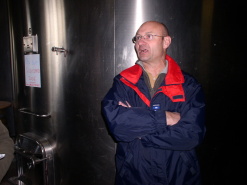 Next stop was Château Queyssard (www.vignobles-masse.com), just a few miles down the road in Pompignac, a winery and farm run by the Massé family since 1890. The current owners, Francis and Martine Massé, who gave us an extensive tour with appropriate tastings, made the decision to aim for quality whilst always respecting the force of the environment. Stainless-steel fermentation was installed. The estate now also includes Domaine de Terrefort-Bibonne, which he has renovated and where wine is matured in barriques. The principal aim of Vignobles Massé is to offer the customer the optimum quality-to-price relationship. Next stop was Château Queyssard (www.vignobles-masse.com), just a few miles down the road in Pompignac, a winery and farm run by the Massé family since 1890. The current owners, Francis and Martine Massé, who gave us an extensive tour with appropriate tastings, made the decision to aim for quality whilst always respecting the force of the environment. Stainless-steel fermentation was installed. The estate now also includes Domaine de Terrefort-Bibonne, which he has renovated and where wine is matured in barriques. The principal aim of Vignobles Massé is to offer the customer the optimum quality-to-price relationship.
Finally we were taken to Château Courtade-Dubuc (www.courtade-dubuc.com) a 19th century manor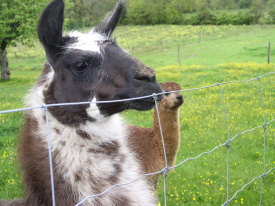 house in Camblanes et Meynac, whose owner, Hubert Daron, welcomed us in person. This is no chore as he always prefers to show visitors round himself. His father bought the property as recently as 1987, with Hubert, the youngest son, being in charge since 1994. This property has a limited production of about 60,000 bottles a year from 10 hectares. Surprisingly one sees llama and alpaca wandering free in the wooded grounds surrounding the château, testament to the Bolivian descent of the owners. house in Camblanes et Meynac, whose owner, Hubert Daron, welcomed us in person. This is no chore as he always prefers to show visitors round himself. His father bought the property as recently as 1987, with Hubert, the youngest son, being in charge since 1994. This property has a limited production of about 60,000 bottles a year from 10 hectares. Surprisingly one sees llama and alpaca wandering free in the wooded grounds surrounding the château, testament to the Bolivian descent of the owners. 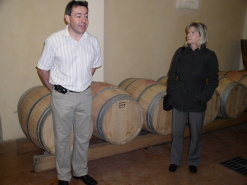 Here we tasted the wines accompanied by a selection of local produce from the estate, such as pork rillettes, duck magret, cured ham and a selection of jams and confits de vin called Les Courtadises made under the auspices of a local confrérie, Bienvenue á la Ferme en Gironde, a voluntary association of local farms (including Château Courtade-Dubuc) that have dedicated themselves to producing a range of hand-reared meat products, ancient vegetable Here we tasted the wines accompanied by a selection of local produce from the estate, such as pork rillettes, duck magret, cured ham and a selection of jams and confits de vin called Les Courtadises made under the auspices of a local confrérie, Bienvenue á la Ferme en Gironde, a voluntary association of local farms (including Château Courtade-Dubuc) that have dedicated themselves to producing a range of hand-reared meat products, ancient vegetable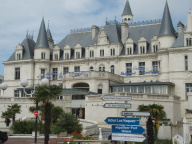 varieties, cheeses, honey and other generally organic gastronomic produce, including wine. Some farms provide accommodation, camping or horse-riding facilities. All this is aimed at providing a taste of the Gironde for the visitor. varieties, cheeses, honey and other generally organic gastronomic produce, including wine. Some farms provide accommodation, camping or horse-riding facilities. All this is aimed at providing a taste of the Gironde for the visitor.
The second day of this info-excursion saw us in Arcachon, an elegant seaside resort and spa an hour from Bordeaux by fast road. A tour 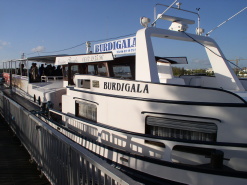 through the town led to the cluster of camp sites around the imposing 104 metre-high and 4 km long sand dune (la Dune de Pilat), the highest in Europe, which contains around 60 million tons of sand and is a listed site. Later we visited the oyster farm of Mme Angelica Hermann, one of hundreds such in the tidal reaches of la Teste de Buch in Le Bassin d'Arcachon, near the town. This area forms the principal breeding grounds for oysters in Europe. A fascinating explanation of the rearing of these delicious molluscs led to a tasting of a dozen washed down with cool refreshing Sainte Foy white Bordeaux from Château Trois Fonds. through the town led to the cluster of camp sites around the imposing 104 metre-high and 4 km long sand dune (la Dune de Pilat), the highest in Europe, which contains around 60 million tons of sand and is a listed site. Later we visited the oyster farm of Mme Angelica Hermann, one of hundreds such in the tidal reaches of la Teste de Buch in Le Bassin d'Arcachon, near the town. This area forms the principal breeding grounds for oysters in Europe. A fascinating explanation of the rearing of these delicious molluscs led to a tasting of a dozen washed down with cool refreshing Sainte Foy white Bordeaux from Château Trois Fonds. An evening boat trip on the river cruiser Burdigala (again with tasting) took us briefly towards the 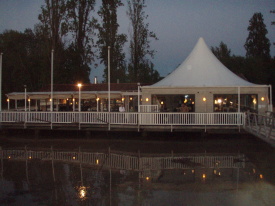 ocean before returning back up river, beyond the city, past the hundreds of fishermen's cottages perched tantalisingly over the water, ending up in the twilight at la Maison du Fleuve, a fine and pleasingly romantic restaurant among the reeds on the river's edge. A fitting end to our five-day sojourn in the world’s largest quality-wine region. So much still to see... ocean before returning back up river, beyond the city, past the hundreds of fishermen's cottages perched tantalisingly over the water, ending up in the twilight at la Maison du Fleuve, a fine and pleasingly romantic restaurant among the reeds on the river's edge. A fitting end to our five-day sojourn in the world’s largest quality-wine region. So much still to see...
For the record, back to the Concours Mondial itself, from the 72 samples entered from the Czech Republic, 17 conquered Bordeaux with medals, of which six were gold! Golds were awarded to: Bohemia Sekt Louis Girardot 2003); Oldøich Drápal's (Traminer 2004); Mikrosvín (Traminer 2006); MVZ Bzenec (Ego No. 81 Riesling 2006); Skoupil Petr (Merlot 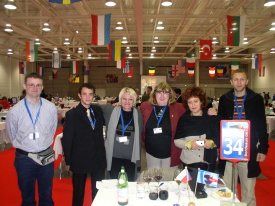 2006 barrique) and Znovín Znojmo (Riesling 2006). Silvers went to Bohemia Sekt Prestige Demi-Sec; Oldøích Drápal's Pinot Gris 2005 and Riesling 2004; Ego No. 57 Chardonnay 2005, Ego No. 72 Grüner Veltliner 2006 and Ego No. 72 Grüner Veltliner 2005 from MVZ Bzenec; Chardonnay 2007, Cuvée Ardea 2006 and Cuvée Cygnus 2006 from Nové vinaøství; Sauvignon Blanc 2003 from Václav Ovèáèík and Pálava 2006 from Vinselekt Michlovský. 2006 barrique) and Znovín Znojmo (Riesling 2006). Silvers went to Bohemia Sekt Prestige Demi-Sec; Oldøích Drápal's Pinot Gris 2005 and Riesling 2004; Ego No. 57 Chardonnay 2005, Ego No. 72 Grüner Veltliner 2006 and Ego No. 72 Grüner Veltliner 2005 from MVZ Bzenec; Chardonnay 2007, Cuvée Ardea 2006 and Cuvée Cygnus 2006 from Nové vinaøství; Sauvignon Blanc 2003 from Václav Ovèáèík and Pálava 2006 from Vinselekt Michlovský. Full results and further information on Concours Mondial de Bruxelles can be found on: www.concoursmondial.eu
|


